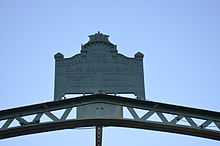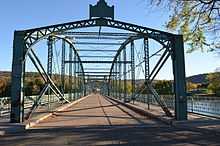Berlin Iron Bridge Co.
The Berlin Iron Bridge Co. is a company that built iron bridges and buildings that were supported by iron. It is credited as architect of numerous bridges and buildings now listed on the U.S. National Register of Historic Places. It eventually became part of the American Bridge Company.
Bridges

The plaque on the South Washington Street Parabolic Bridge
Its works include:
- Bardwell's Ferry Bridge, built in 1882, a lenticular truss bridge
- Interlaken Mill Bridge, Rhode Island, built 1885 spanning the Pawtuxet River
- Lover's Leap Bridge, a wrought-iron lenticular truss bridge over the Housatonic River, built in 1895
- Ouaquaga Lenticular Truss Bridge, a lenticular truss bridge
- Raymondville Parabolic Bridge, a lenticular truss bridge
- Berlin Bridge over Webutuck Creek, a lenticular truss bridge manufactured in 1880 and shipped to the area for installation by local residents
- South Washington Street Parabolic Bridge, a lenticular truss bridge
- Town Line Bridge, located in the town of Taylor in Cortland County, New York, constructed in 1888
Individually NRHP-listed, surviving ones
- Ashland Mill Bridge, over the Pachaug River, near Ashland St., Griswold, CT
- Bardwell's Ferry Bridge, Bardwell's Ferry Rd. over the Deerfield River, Conway, MA
- Beaman and Smith Company Mill, 20 Gordon Ave., Providence, RI
- Boardman's Bridge, Boardman Rd. over the Housatonic River, NW of New Milford, CT
- Capewell Horse Nail Company, 60-70 Popieluszko St., Hartford, CT
- Douglas & Jarvis Patent Parabolic Truss Iron Bridge, Rte. 2 over the Missisquoi River, Highgate Falls, VT
- Glen Falls Bridge, Brunswick Ave. over the Moosup River, Plainfield, CT
- Golden Hill Bridge, Golden Hill Rd. over the Housatonic River, Lee, MA
- Hadley Parabolic Bridge, CR 1, Hadley, NY
- Interlaken Mill Bridge, spanning the Pawtuxet River at Arkwright, Coventry, RI
- Lover's Leap Bridge, S of New Milford on Pumpkin Hill Rd., New Milford, CT
- Main Street Bridge, carrying Main St. over the Rippowam River, Stamford, CT
- Melrose Road Bridge, Melrose Rd. over the Scantic River, East Windsor, CT
- Minortown Road Bridge, Minortown Rd. over the Nonewaug River, Woodbury, CT
- Ouaquaga Lenticular Truss Bridge, Dutchman Rd. over the Susquehanna River, Ouaquaga, NY
- Pineground Bridge, 0.15 mi. E of NH 28 on Depot Rd., Chichester, NH
- Providence Gas Company Purifier House, 200 Allens Ave., Providence, RI
- Raymondville Parabolic Bridge, Grant Rd. over the Raquette River, Raymondville, NY
- Red Bridge, near Oregon Rd. over the Quinnipiac River, Meriden, CT
- Rice Farm Road Bridge, Town Hwy. 62, off VT 30, Dummerston, VT
- Sheffield Street Bridge, Sheffield St. over Hancock Brook, Waterbury, CT
- South Washington Street Parabolic Bridge, S. Washington St., Binghamton, NY
- Swing Bridge, over the Ausable River, between Clinton and S. Ausable Sts., Keeseville, NY
- Town Bridge, over the Farmington River, Canton, CT
- Town Line Bridge, Town Line Rd., Taylor, NY
- Turn-of-River Bridge, Old N. Stamford Rd. at the Rippowam River, Stamford, CT. A small lenticular pony truss bridge
- Walton Bridge, Dr. Ray Rd. access over the Ausable River, Keene, NY
- Waterville Bridge, Appalachian Trail over Swatara Creek, Swatara Gap, PA
Buildings

Detroit Dry Dock Company's machine shop in 1912 (right background), built in 1892
- Providence Gas Company Purifier House
- Dry Dock Engine Works-Detroit Dry Dock Company Complex, which featured a load-bearing steel frame and non-load-bearing brick curtain walls, at the time a novel construction technique.[1] The 1892 machine shop was constructed to take advantage of what was at the time the most modern innovations applied to manufacturing buildings: electric drive machinery and an electrically driven traveling overhead crane.[2] The tall, wide construction of the building, containing an open space lacking support columns, reflects the desire to implement the crane into the company's manufacturing process.[2] In fact, contemporaneous material from the Detroit Dry Dock Company extols the virtues of the open plan of the building, the "great advantages of light and air" afforded by the skylight and windows, and the effectiveness of the crane.[3] The open space in the building was possible due to the construction of the building in what was at the time a novel method. Steel frame construction had emerged in 1880s Chicago in the construction of office buildings, the first being the nine-story Home Insurance Building, constructed in 1884.[4] However, the first building to be completely supported by a riveted all-steel frame was the 1889 Rand McNally Building.[4] The steel frame allowed the exterior walls to be reduced to a simple curtain covering the frame, rather than supporting the weight of the building. The Berlin Iron Bridge Company, already experienced in riveted steel construction through their bridge construction, moved into the design and construction of steel-framed industrial buildings at some time in the late 1880s.[5] The particular design used by the Berlin Iron Bridge Company represented a conservative, hybrid design.[6] The steel frame completely supported the structure, but the non-load-bearing curtain walls were nonetheless designed the same way as traditional brick load-bearing walls.[6] Eric J. Hill and John Gallagher, in their American Institute of Architects guide to Detroit architecture, state that this building is perhaps "the most important surviving nineteenth-century industrial building in Detroit."[7]
References
- ↑ Klug, p. 24
- ↑ 2.0 2.1 Klug, p. 26
- ↑ Around the Lakes p. 86.
- ↑ 4.0 4.1 Klug, p. 27
- ↑ Klug, p. 30
- ↑ 6.0 6.1 Betsy H. Bradley, The works: the industrial architecture of the United States, 1999, Oxford University Press, ISBN 0-19-509000-4 p. 149-150
- ↑ Eric J. Hill, John Gallagher AIA Detroit: the American Institute of Architects guide to Detroit architecture, 2003, Wayne State University Press, ISBN 0-8143-3120-3, p. 229
External links
- Berlin Iron Bridge Company web presentation

